How to choose a drain overflow for your bathtub: useful tips
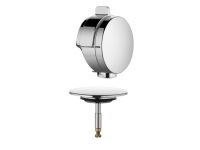
We do not often think about how the most basic and familiar things in the house work, until we are faced with the question of repairing or replacing this thing. However, by understanding the principle of operation of this or that equipment, we can not only easily choose the most suitable option among the dozens presented in the stores, but also by our own efforts to extend its service life.
Today we will look at the drain-overflow system for the bathtub, learn about its structure, the principle of operation and about the available varieties.
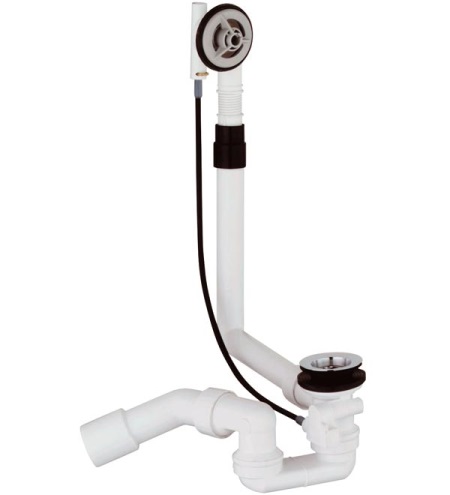
Drain-overflow or piping is a system that ensures the drainage of water from the bathtub into the sewer system and protects the bathtub from overflowing. In other words, the overflow drain consists of two holes - in the bottom and the bathtub wall, which are connected to each other and to the drainage system with the help of a system of pipes and hoses. We will talk more about the various modifications of overflow drains below.
Traditional system
The traditional overflow drain we have seen in our apartments for many decades. This system allows you to fill the bathtub with water by closing the drain with a plug on a chain. It consists of the following elements:
- The drainage neck. positioned in the opening at the bottom of the bathtub and connected to the rest of the network with a direct water outlet;
- Overflow connection is positioned in an opening in the bath tub wall and connected to the water supply system by a lateral water drain;
- Siphon - is a curved pipe which acts as a stopper and prevents unpleasant odors from entering the room from the sewer system;
- Connecting hose - is a corrugated tube that serves to drain water from the overflow into the siphon;
- Outlet tube - carries out the drainage of water from the siphon into the sewer.
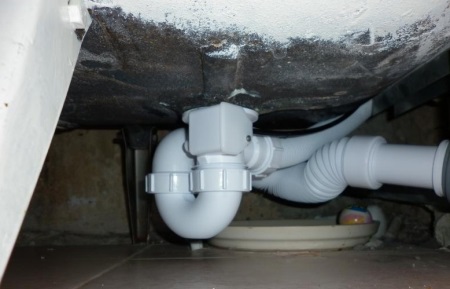
This is a standard set of elements that make up a traditional drain-overflow system. Assemble and disassemble such a design can be any person who does not have special knowledge in the field of plumbing. The most common procedure, which sooner or later will have to almost every owner of a traditional overflow drain - is the replacement of the connecting parts of the structure, in other words - seals.
Semi-automatic
A later modification of the traditional overflow drain are semi-automatic systems. From its predecessor, these systems have retained the drain siphon and drain pipes, but otherwise the design has undergone some changes. It consists of:
- A control unit - The system that allows you to raise and lower the plug. This can be a button, swivel ring, handle or valve;
- The plugThe plug, which acts as a valve;
- The cableThe plug, which acts as a valve; The cable that operates the plug.
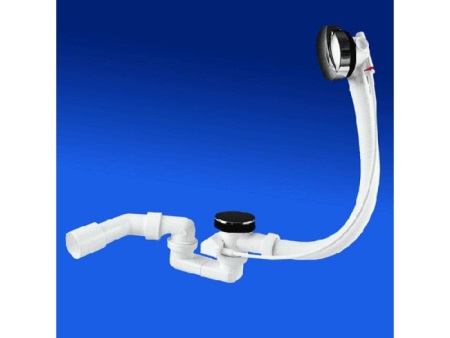
The control unit is actuated by pressing the button and turning the valve, which activates the cable, the tension or looseness of which raises or lowers the plug. In this design, the overflow port is hidden behind the control unit. The external, visible elements of overflow drains often have a beautiful and stylish design, which is sure to bring a certain amount of aesthetics. Another advantage of this design is that it becomes very convenient to raise and lower the plug, as it is not even necessary to bend over the bathtub and wet your hands.
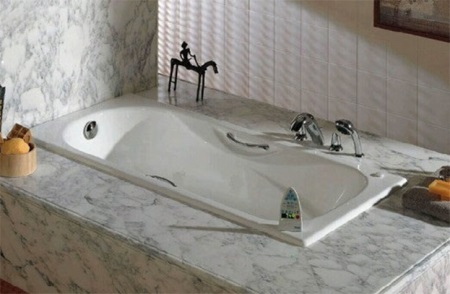
The disadvantage of this system is its very relative reliability. If you save money and buy an inexpensive model, then it will serve you very shortly, so it is better to opt for more expensive products or do the traditional system of drain overflow.
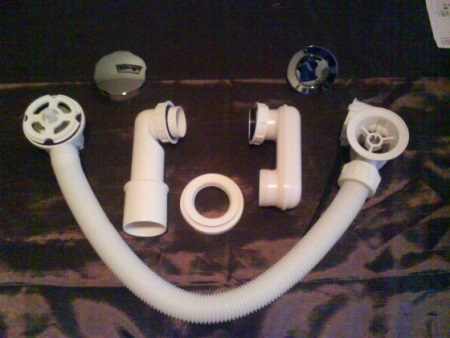
Automatic
Drain automatic for the bathroom on the structure and principle of action is little different from the constructions we discussed above. The main innovation is a special, automated plug-valve. This plug is equipped with a spring with a locking device. When pressed, the plug lowers and clogs the bathtub drain. When you press it again, it rises and the water drains out. Children's bathtubs are often equipped with an automatic drain. The presence of a button-valve allows you to empty the tub without turning it upside down.
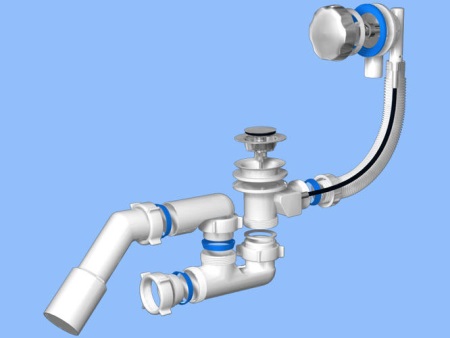
The automatic system is the most ergonomic of all. You can control it not only with your hands, but also with your feet. In addition, the visible part of this design takes up very little space. Buttons are available in a variety of designs - among them you can find brass, stylized antique, or chrome, in the style of high-tech.
The disadvantage of an automatic flush system is that the replacement of the button-valve is a great difficulty. If it fails, you'll have to replace the entire drain-overflow system. However, this problem can be avoided if you buy a device from a reliable, proven manufacturer that works only with high quality materials. About what materials are used in the production of bath overflows, we will talk in the next section.
Materials
For the manufacture of drains-overflows for the bathtub is usually used plumbing plastic or metal.
Plastic version is always cheaper, but not always of lower quality. For example, plastic is less susceptible to corrosion, which can be caused by water and impurities present in it. In addition, the plastic overflow drain is very easy to install.
The disadvantage of plastic models can be considered not quite aesthetic appearance. Meanwhile, if a screen is provided under the bathtub, the main part of the structure will remain invisible, so there is no need to worry about what impression the "insides" of your bath will make on the guests.
In addition to plastic models, there are variants of overflow systems on the market, made of black or colored metal. Metal structures look very elegant and, at the same time, solid. They are indispensable if you have a bathtub, which does not imply the presence of a closing screen.
The most beautiful overflows are made of base metal alloy - bronze, copper and brass. On top of the product is applied an additional coating, which determines its color - chrome, nickel and others. Metal structures are more expensive, but also more robust and durable than plastic.
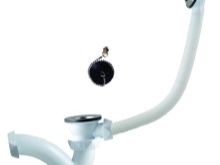
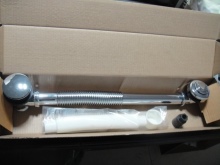
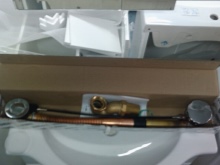
Manufacturers and prices
It is no secret that the highest quality sanitary ware, as well as many other groups of products, is produced in European countries. The overflow drain system is no exception, so when buying it, special attention should be paid to European manufacturers.
In the field of production of automatic drain overflow systems, the first steps were made by the German company "Kaiser". Today, the drain-overflow from this manufacturer will cost you 2000-2500 rubles.
Also very well proven itself Swiss company "Geberit", engaged in the production of high quality sanitary ware, including metal systems, drain overflow. Drainage structure of this company costs about 2000-4000 rubles, depending on the material from which it is made. You can be confident in the quality of products of this company, as it provides a ten-year warranty on its products.
The firm "Grohe", also German, produces high-quality drains, overflows. The products of this company are quite expensive. For example, a plastic overflow drain costs an average of 5,000-6,000 rubles.
Not bad systems of plastics overflows and drains are made by Italian company "Vega" and Czech company "Alcaplast". The products of these companies can be purchased for 2000-3000 rubles.
Installation with your own hands
Installation of the overflow drain is a responsible thing, since the quality of the work performed will largely depend on the tightness of the bath. However, despite the apparent complexity of the task, to cope with the installation of the drain-overflow on the bathtub is quite possible and a layman.
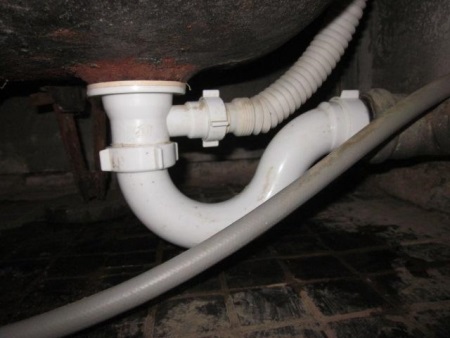
You can start the work only when the bathtub is installed on the support, aligned and secured. It is necessary that the clearance between the tub and the floor is at least 15 cm.
To begin with, attach a tee to the drain hole, not forgetting to lay a gasket, and secure everything with a screw. Then connect the siphon to the branch of the tee, secure the construction with a nut and seal with a cone rubber sleeve. Next, take the overflow neck and attach it to the siphon outlet, coming from the side. Finally, attach the spout to the siphon and lead it down the drain. Don't forget the gaskets at each step!
After installation, be sure to check the entire system for leaks. Fill the tub and see if any drops of water appear at the connections. If you find any leaks, tighten the connections or use sealant.
Maintenance Tips
Overflow drain systems do not require special care. If you have a semi-automatic or automatic system, occasionally clean the exterior metal parts with glass cleaners or special cleaners to maintain their original shine. The inside of the structure should be inspected periodically for leaks. In the event of a leak, it is usually sufficient to change the gaskets or tighten the connection.

The main cause of concern related to the drain-overflow system is a clogged siphon. This happens when a lot of hair or dirt accumulates in the drain. In this situation, a plunger or a homemade device consisting of a wire and a thin brush is usually helpful. You can also try a variety of chemical clog removal products that contain alkali. These remedies can also be used to prevent clogs from occurring.
Now you know a little more about the principle of the bathtub overflow drain system and its varieties. We hope that our article will help you not be confused in the store and make the right choice!





I have an overflow drain Grohe. Worth 3 years. Satisfied with everything.
The article does not tell you such a problem with semi-automatic as a failure of the cable opening-closing the drain plug. The bathtub is full and the cable refuses to work, and there nekodovyvayuschy plug ... they say it's related to water stone or just wear and tear, it happens to many people with Kaiser, I also had a Kaiser die after about 3 years of use, plugged with a regular plug. And after another couple of years this Kaiser started leaking from the rear overflow tube connection, in the middle. With a heavily filled bathtub when draining water from the pressure, the water rises and flows out of the overflow drain connection at 0.5 meters from the ground. There are not a few complaints on the internet about the Kaiser system - the cable stops working.